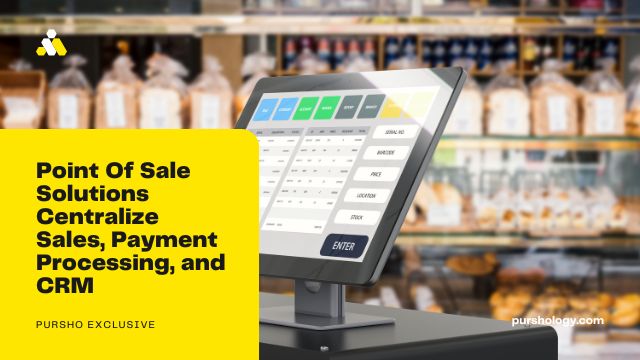POS systems are often designed to work across large, disparate networks of several hundred to thousands of machines. But the truth is that some POS systems can be used across very few machines. The reason for this is that a single network can support only one database, and there are other requirements—such as a secure method of transmitting data from the user’s terminal to the database server—that make it difficult for two similar systems to operate on the same network.
Once you have found your solution, you need to figure out what is needed for your specific situation and then determine how best to provide it (with some general guidelines). In many instances, there will be prerequisites that must be met before you can begin implementing; in others, system design elements will take precedence over requirements (e.g., if you want an inventory tracking system to work across different devices and platforms, then you must design a system that supports storing sales data in multiple formats). The next step is figuring out what each requirement means in terms of implementation—what the actual process looks like and how much time it takes.
If it seems like at least one or two points are missing on your list, don’t worry: there is no right answer or wrong answer here. You just need to figure out what your priorities are and take steps towards meeting them. Once you have gained some confidence in your ability to achieve certain goals, maybe by getting into a semi-functional prototype first? Or maybe by building a proof-of-concept app? Or perhaps by implementing some form of automated testing? Whatever route you decide upon, keep in mind that even the simplest application has many moving parts: a software development kit (SDK), an operating system (OS), an API or other platform-level technology (e.g., Java or C#), hardware components such as disk drives and printers, and all sorts of other secondary jargon that gets glossed over quickly when most people think about POS applications.
2. The best POS systems also include robust tools for inventory tracking, vendor management, employee management, and customer loyalty.
The best POS systems also include robust tools for inventory tracking, vendor management, employee management, and customer loyalty.
A well-documented history of inferior POS systems aside, the main reason why many people don’t use them is because they are so expensive. The best POS systems can cost between $100,000 and $200 million (and this is before accounting for the hardware). Thus despite all the hype around their power — and sometimes even despite their legal obligations to do so (but more on that later) — they are just not very practical as a product that people actually want to buy.
The good news is that there are plenty of good reasons to use them: if you want to sell high value products on a scale unparalleled by any other retailer in the world, then a POS system will be invaluable. If you want to grow your sales team quickly — or if you have an existing sales pipeline which needs to scale up quickly — then a POS system will be indispensable. And if you need to track inventory on a scale which dwarfs any other retailer on earth, then a POS system will be one of the key ways in which you do so.
However, it is important to realize that every single one of these functions has its own specific trade-offs:
POS systems tend not to have robust inventory tracking features (e.g., shipping tracking) or optimized customer loyalty features (e.g., automatic restocking).
POS systems tend not to be able to integrate with any critical internal data sources like CRM software or back office accounting software (e.g., if your company has customers who change frequently across regions or products they should not be able to integrate with different software).
POS systems tend not provide robust tools for handling inventory tracking themselves (which means they cannot support multiple vendors simultaneously), or for managing vendors or employees securely (which means those same vendors have access control mechanisms and user authentication mechanisms built into their software which must be maintained by the vendor).
POS systems tend not offer user-friendly interfaces for users who don’t speak English; in fact, many POS systems lack even English translations into their underlying languages.
What this means is that most companies operating higher-end POS systems are running out of money before they reach “point of sale” status even though they know that each function has its own trade-offs and there is no reason why anyone should expect them all at once. So what happens when you need each function?
3. POS systems can streamline sales and help businesses keep track of customers and inventory.
POS systems are primarily used by large retailers and restaurants. In addition to the POS module, a POS system can include:
• Point of Sales (POS) software
• Point of Sale (PO) hardware
• Point of Sale (POS) printers
• Point of Sale (POS) scanners
• Point of Sale (POS) accessories
• Point of Sale (POS) servers
The good news is that there are many POS solutions on the market. The bad news is that most POS solutions are not very good. The term “point-of-sale” represents a simplified view of how businesses approach their inventory management. In reality, many products offer more than just point-of-sale functionality, and some vendors offer a full end-to-end solution that includes inventory management, sales and marketing automation, CRM systems, software development platforms and more. While it is unclear what exactly a point-of-sale solution will include, depending on the vendor or software company involved, it could involve: • Software for accounting functions needed for data entry/processing; • Inventory management tools; • Purchasing; • Order processing; • Customer relationship management (CRM); • Billing systems; • Customer loyalty programs; • Recruiting/job posting tools; etc.
The most efficient way for a company to assess its POS system would be through extensive research using different vendors’ software download programs or online reviews of different POS systems — but most companies don’t do that because they don’t want to spend money on something they might not be able to afford if they go wrong. If you’re in that boat, I’d suggest you try out a few different companies’ products before you settle on one vendor’s product as the only choice. Also keep in mind that while some hardware may seem impressive because it may cost thousands and even tens of thousands of dollars (or more), it isn’t always worth it — which is why we recommended buying several products rather than buying one single item which could be faulty or break down any day now. You should also keep in mind that these days prices can vary quite dramatically from one vendor to another so you might pay significantly less than you expected going into an agreement with such a vendor — or even more if you’re thinking about future discounts! For example: Apple’s iPad Pro 10″ starts at around $700 retail ($499 direct), while Amazon’s Kindle
4. POS systems can also help businesses manage employees and customers more effectively.
A point-of-sale (POS) system is a combination of software and hardware that centralizes sales, payment processing, and customer relationship management (CRM). The best POS systems also include robust tools for inventory tracking, vendor management, employee management, and customer loyalty.
In this post on Medium the author elaborates on what makes a good point-of-sale system:
One of the most important measures of value is how well your POS system handles inventory. If you can’t slide items from one side of your store to the other in a matter of seconds after making a sale, you aren’t doing it right. Your goal should be to get items to customers as fast as possible — not seconds later. It’s equally important that your employees understand what’s going on around them and have easy access to sales data. Lastly, you need an inventory management tool that keeps track of everything for you — including what products are marked down and when.
The author goes on to mention some points about replenishment and sales performance:
You need replenishment technology. The amount of cash that must be brought in to keep up with demand is limited by both your physical store location and software limits — so there isn’t much wiggle room left if you want to do more than one item at a time at our level. And while some hardware companies are building solutions like lockers or undercounter shelves that can handle larger amounts of product or multiple items per aisle without compromise, our approach has always been simple: let us manage all the inventory so we can focus on getting products into customers hands as quickly as possible… Another big problem with using stock levels manually is that they tend to fluctuate wildly over time — which means people will often wait for days or weeks before checking back in with their order status and availability… When an item sells out it gets put back in stock unless someone in human resources calls us and tells us not to do so… Our solution makes use of a “promotional product” feature built into our software which automatically restocks items when they go off sale automatically without any need for any human intervention… We also build automatic replenishments based on historical sales data so we know exactly how long it takes for any given item to sell out completely before automatically restocking it again… Our goal is never for our system to be 100% accurate but rather for it to always be within 10% or even less when factoring
5. POS systems can be tailored to fit the specific needs of any business.
POS systems are very commonly deployed in point-of-sale (POS) systems such as POS terminals, POS software, and POS hardware. In addition to the usual electronic payment processing and customer relationship management functions, POS systems can also be tailored for an array of other business and customer needs.
While the requirements for a POS system vary depending on the type of business and its industry, some common use cases include:
• Point-of-sale (POS) terminals – These are small devices that provide a way to pay with cash or credit or debit cards at vending machines, self-service kiosks or restaurants. These will typically be used in combination with other equipment such as cash registers that can process credit card transactions.
• Software – Software is often used in conjunction with POS terminals to facilitate accounting functions such as inventory management, payroll, invoicing and accounting reporting. Software typically combines an internal database with an external Web interface to allow employees to manage inventory using their handheld device.
• Handset – Handheld devices are increasingly being integrated into POS systems to enhance security and improve the overall user experience by providing easy access to multiple applications without having to rely on a network connection.
• Equipment – Equipment including cash drawers, shelves, shelves and shelves may also be included in some locations but will generally not be required in others due to available space constraints or other constraints on equipment use.
If you want an overview of what kinds of functionality can be offered by different types of POS solutions , you should read up on our blog post on “What is a Point of Sale System?” here . In short: if you need:
• Cashier or Cashier Machine (CMM) – A CMM is essentially a combination cash register and barcode scanner that allows customers to pay for goods using their credit card or debit card(s) at vending machines or self service kiosks where available. These tend not to require inventory tracking capabilities because they only require that the machine have a working credit card reader attached when being used by customers. They are most commonly used for vending machines but have been used for self service kiosks in recent years because they are less expensive than dedicated barcode scanners but offer much more convenience than standalone cash registers do (as they allow customers who don’t want their own credit cards) which makes them attractive options for many businesses who don’t want any additional expenses associated with handling chargebacks from customers who choose not
6. The right POS system can save a business time and money.
The right POS system can save a business time and money.
Before you get too excited, take some time to read the above paragraph once again. The point isn’t necessarily that a POS system will save you money or faster checkout times, but that it can in fact do so. If your company routinely spends a very high percentage of revenue on sales, or if you find yourself running out of cash on a regular basis, the point of selling on POS systems is worth exploring.
7. A POS system is a valuable investment for any business.
Are you using the same sales force for all your products? Yes, it’s a good idea. Your salesforce should be composed of people who are experts in your field. However, there are some risks associated with over-reliance on a single sales force.
For example, it’s not unheard of for a single salesperson to make several errors in a single sale. In the worst case scenario, that one mistake can lead to the loss of hundreds or thousands of dollars (or even millions). That is why it’s important to have more than one salesperson covering different products and territories.




